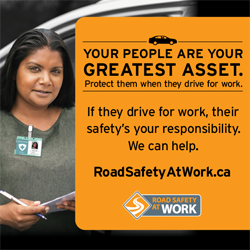Every day community and home care workers across B.C. spend a significant amount of time on the road driving vehicles as part of their work. Tight schedules, unexpected demands, and a potential lack of familiarity with routes and locations puts workers at high risk when on the road.
 As an employer or supervisor, you’re legally responsible for the safety of your workers when they drive for work. This includes employees who are on the road all day or just once or twice a week, or whether they drive a company-owned vehicle or their own personal one.
As an employer or supervisor, you’re legally responsible for the safety of your workers when they drive for work. This includes employees who are on the road all day or just once or twice a week, or whether they drive a company-owned vehicle or their own personal one.
The following information will help reduce the risk your workers face when driving during winter months.
Four actions to reduce the risk of a winter driving crash
1. Determine if driving for work is necessary. Direct your workers to always check road and weather conditions on DriveBC.ca before leaving home to determine whether it’s safe to drive. Encourage them not to drive if the weather conditions are unsafe or worsening. Cancel, reschedule or reroute trips when necessary.
2. Plan the trip. If driving is necessary, direct workers to develop a trip plan including determining the safest route, alternate routes in case of closures or conditions. Ask them to determine if their vehicle right for the trip, is it equipped for road and weather conditions?
3. Prepare worker’s vehicles. A prepared vehicle means a safer journey. Instruct workers to:
• Install four-matched winter tires with the three-peaked mountain and snowflake symbol for better traction in cold weather (7°C or less). Most B.C. highways require passenger vehicles to use Mud and Snow (M+S) or three-peaked mountain and snowflake tires between October 1 and March 31.
• Keep first aid supplies and a winter survival kit in the vehicle.
• Before driving, remove snow and ice from windows, lights, mirrors and vehicle surfaces.
4. Drive for the conditions. Make sure drivers know how to drive for the conditions before they get behind the wheel.
a. Slow down, drop speed to match road conditions. The posted speed is the maximum under ideal road conditions.
b. Mainitain a safe following distance – at least four seconds. It takes longer to stop on a slippery road.
c. Learn or be trained in winter driving skills.
Additional Resources
ShiftintoWinter.ca offers free information and resources to help you comply with your legal responsibilities and reduce the risks your employees face when they drive during winter. There is a guide to address the specific needs of community and home care workers. As well, there is an employer tool kit, tip sheets and tailgate meeting guides, and an online course designed specifically for employers and supervisors.
Using these free resources will help enhance employee safety which in turn can lead to better client outcomes, reduced organizational costs, and improved business performance. Meeting your health and safety responsibilities is a win-win for everyone.
Download Winter Driving Safety for Community and Home Care Workers [PDF 1 MB].
+++
This is a sponsored bulletin. To learn more about BCCPA’s online promotional opportunities, click here.





